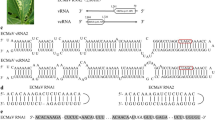Abstract
A new virus was detected in common fleabane (Erigeron annuus) showing virus-like symptoms including leaf yellowing, mosaic, and mottling. This virus is tentatively named "fleabane yellow mosaic virus" (FbYMV). The complete genome sequence consists of two RNA segments of 7,133 nt (RNA 1) and 4,810 nt (RNA 2), excluding the poly(A) tract. Sequence analysis showed a genome organization comparable to that of members of the genus Torradovirus. The level of sequence identity between FbYMV and known members of the genus Torradovirus was below the cutoff established by the ICTV for species demarcation. Therefore, FbYMV should be classified as a new member of the genus Torradovirus.


Similar content being viewed by others
References
Nesom GL (2006) Erigeron annuus. Flora Norh Am 20:344
Song U, Son D, Kang C et al (2018) Mowing: A cause of invasion, but also a potential solution for management of the invasive, alien plant species Erigeron annuus (L.) Pers. J Environ Manage 223:530–536. https://doi.org/10.1016/j.jenvman.2018.06.057
Zhou J, Li J, Peng S, An X (2022) Characterization of the complete chloroplast genome of the invasive plant Erigeron annuus (L.) Pers. (Asterales: Asteraceae). Mitochondrial DNA Part B Resour. 7:188–190
Thompson JR, Dasgupta I, Fuchs M et al (2017) ICTV virus taxonomy profile: Secoviridae. J Gen Virol 98:529–531. https://doi.org/10.1099/jgv.0.000779
Van Der Vlugt RAA, Verbeek M, Dullemans AM et al (2015) Torradoviruses. Annu Rev Phytopathol 53:485–512. https://doi.org/10.1146/annurev-phyto-080614-120021
Ferriol I, Silva Junior DM, Nigg JC et al (2016) Identification of the cleavage sites of the RNA 2 encoded polyproteins for two members of the genus Torradovirus by N-terminal sequencing of the virion capsid proteins. Virology 498:109–115. https://doi.org/10.1016/j.virol.2016.08.014
Mann KS, Walker M, Sanfaçon H (2017) Identification of cleavage sites recognized by the 3C-like cysteine protease within the two polyproteins of strawberry mottle virus. Front Microbiol 8:1–13. https://doi.org/10.3389/fmicb.2017.00745
Katoh K, Standley DM (2013) MAFFT multiple sequence alignment software version 7: improvements in performance and usability. Mol Biol Evol 30:772–780. https://doi.org/10.1093/molbev/mst010
Kumar S, Stecher G, Tamura K (2016) MEGA7: Molecular Evolutionary Genetics Analysis Version 7.0 for Bigger Datasets. Mol Biol Evol 33:1870–1874. https://doi.org/10.1093/molbev/msw054
Acknowledgements
This work was funded by the USDA ARS National Plant Disease Recovery System. Robert Alvarez-Quinto is supported by the Republic of Ecuador through the Ecuadorean Science and Technology Secretariat (SENESCYT).
Author information
Authors and Affiliations
Contributions
All authors have read and agreed to the published version of the manuscript. Conceptualization: Dimitre Mollov, John Hammond, William Wintermantel. Methodology: Robert Alvarez, Samuel C. Grinstead, Stephen Bolus, Dimitre Mollov. Formal analysis and investigation: Robert Alvarez, Samuel C. Grinstead, Stephen Bolus. Writing – original draft preparation: Robert Alvarez, Dimitre Mollov. Writing – review and editing: Robert Alvarez-Quinto, Samuel Grinstead, Stephen Bolus, Margery Daughtrey, John Hammond, William Wintermantel, Dimitre Mollov. Resources: Dimitre Mollov, Margery Daughtrey, John Hammond. Supervision: Dimitre Mollov.
Corresponding author
Ethics declarations
Conflict of interest
All authors declare no conflict of interest.
Ethical standards
This article does not contain any studies with human participants or animals performed by any of the authors.
Additional information
Handling Editor: Sead Sabanadzovic.
Publisher's Note
Springer Nature remains neutral with regard to jurisdictional claims in published maps and institutional affiliations.
Supplementary Information
Below is the link to the electronic supplementary material.
Supplementary Fig. S1
Symptoms observed in common fleabane, includingmosaic, yellowing, and mottling. (A) Common fleabane plant growingoutdoors with symptoms associated with FbYMV infection. (B) Close-upphotograph of a fleabane seedling infected with FbYMV infection. Supplementary file1 (JPG 1042 kb)
Supplementary Fig. S2
Maximum-likelihood (ML) consensus treeconstructed based on the combined amino acid sequences of the CPs (RNA2). The bootstrap value (1000 replicates) is indicated at each branch; thesupport threshold for the consensus tree was set at 70%. The tree is drawn toscale, with branch lengths corresponding to the number of substitutions persite. The position of FbYMV is indicated by a red arrow. Red circles at theend of the taxon names indicate torradoviruses of tomato origin, while bluesquares indicate torradoviruses originating from hosts other than tomato. Supplementary file1 (JPG 1020 kb)
Rights and permissions
About this article
Cite this article
Alvarez-Quinto, R., Grinstead, S., Bolus, S. et al. Genomic characterization of a new torradovirus from common fleabane (Erigeron annuus). Arch Virol 167, 1905–1908 (2022). https://doi.org/10.1007/s00705-022-05497-5
Received:
Accepted:
Published:
Issue Date:
DOI: https://doi.org/10.1007/s00705-022-05497-5




